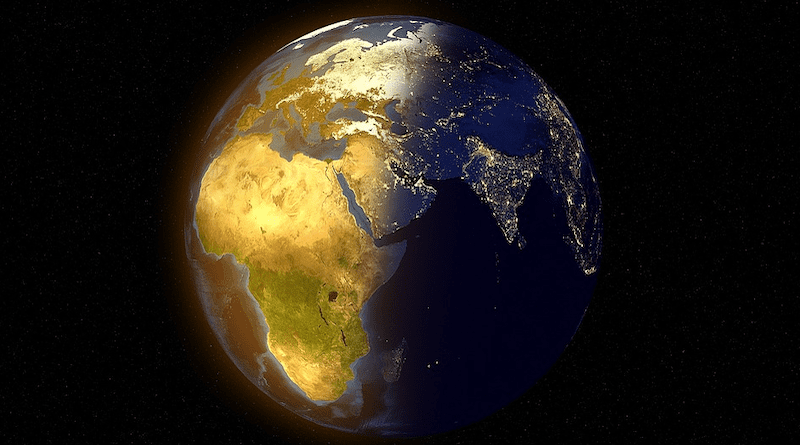Egypt’s Satellites To Boost Africa’s Climate Change Fight – Analysis
Egypt’s space program on Monday took a new leap forward with the launch of another satellite, Horus-2, that will help Cairo monitor climate change in the increasingly thirsty country.
Only 4 percent of Egypt’s land is suitable for agriculture and that figure is shrinking quickly due to a wave of urban and suburban development that is accompanying the country’s population growth, according to NASA’s Earth Observatory. Nasem Badreldin, a digital agronomist at the University of Manitoba, said: “Satellite data shows that Egypt is losing about 2 percent of its arable land per decade due to urbanization, and the process is accelerating. If this continues, Egypt will face serious food security problems.” Cairo is relying more and more on using data from space to find remedies.
Egypt’s space aspirations and formal space program have been focused on climate change monitoring for several decades. Since the 1970s, it has used satellites to measure changes in land surfaces/topography. Its satellites were tied into the National Authority for Remote Sensing and Space Sciences, located in Aswan.
In 1998, Egypt became the first Arab country to launch a telecommunications satellite. Egypt’s second remote sensing satellite, EgyptSat 2, was launched in April 2014, but was lost in space the following year. Four years later, Egypt replaced it with EgyptSat-A, which was launched from the Baikonur Cosmodrome, a spaceport in Kazakhstan that is leased to Russia.
In January 2018, the Egyptian Space Agency became the formal space authority in Egypt. It now administers 11 satellites following the launch of Horus-2. Egypt has used several different countries to launch its satellites, the latest being China.
Egypt’s Horus series is important for its climate change policy. According to Dr. Sherif Sedky, CEO of the Egyptian Space Agency, the Horus-2 satellite will help meet the requirements of Egypt’s 2030 vision for sustainable development. Horus-1 was launched from the Jiuquan Satellite Launch Center in northwest China into a sun-synchronous low Earth orbit in late February.
Horus-2 will identify crop and agricultural land use and the data it provides will help Egypt add to its increasing food self-sufficiency. The Horus satellites contain high-resolution, multi-spectral imaging cameras that capture high-resolution pictures, allowing scientists to understand the surroundings.
In November 2022, Egypt’s hosting of the COP27 climate change conference brought forward its space efforts regarding climate change for North Africa. Cairo’s concern with the effects of climate change go beyond its own agricultural capabilities to the wider African continent. It seeks to use a percentage of its space program for food security by adopting technology pacts with foreign partners. The current partner on this issue is China. Egypt and China are together building the Horus series in the core Middle Eastern state, with Beijing paying for the bulk of the program.
Egypt’s launching of satellites to monitor climate change in Africa is important for confronting climate-related challenges and the resulting phenomena. They monitor any changes as they occur and enable plans to be developed to deal with them. This avoids or limits any damage or negative effects. At COP27, the fact that Egypt’s space program was emphasized as part of the country’s technological edge was welcomed by participants.
The country’s measuring of land use is both urban and rural, but mostly the latter because of the topography and water resources, or lack thereof, especially in the southern part of country, where there are intensive agricultural projects and aqua filters being built or expanded to make up for the loss of water resources due to the Grand Ethiopian Renaissance Dam project. Egypt’s optical satellite imagery is capable of capturing both urban and rural land cover classes, such as vegetation (or even different types of plants), bare soil, water and impervious surfaces (such as roads, parking lots and tin or tile roofs). Egypt’s land use is thus analyzed through these images.
This satellite analysis is used to update Egypt’s national land use and land cover map on a yearly basis, including the monitoring of the marine environment and recording oil pollution for an early warning system, as well as land transformation from agriculture to urban settlements. Plotting the data from Egypt’s climate change-measuring satellites is important to set a standard for the country and its neighbors, which seek to use space science to meet their climate change requirements.
The Egyptian Space Agency next plans to launch two satellites that will specialize in monitoring climate change and plasma fluctuations in the upper atmosphere above North Africa. Egypt also wants to help form the African Space Agency, which has been under discussion for a number of years, and it now looks like Cairo may take action along with its Chinese space partner.
African countries are the most affected and exposed to desertification, water shortages, beach erosion and drought as a result of climate change. Egypt’s space program is beneficial not only for Egypt itself, but for all African countries, and it will have a vital and effective role in facing climate challenges in the years to come.

